The Verreaux’s Eagle – an interview with Dr Rob Davies

I first met Rob Davies in 1995 at the birds collection at the Nairobi Museum where he was researching for his project with Bill Clark on developing a raptor book for Africa. He has been a tremendous inspiration to many artists and raptor biologists around the world and I had the great privilege of staying with him in Midrand South Africa during the WWGBP Meeting there in 1998. Rob interest in birds of prey developed by watching kestrels and peregrines along the Pembrokeshire coastline. He studied zoology at the University of Exeter, and then moved to South Africa in 1982 where he studied the majestic Verreaux’s Eagle in the Karoo National Park for his PhD through Pretoria University. He is one of the finest artists I know and an excellent raptor biologist. He is meticulous in his work, soft spoken and a great person to be with in the field. In this interview, Rob talks passionately to Markus Jais about the status, threats and conservation issues facing the Verreaux’s Eagle. This interview was made possible by the efforts of Markus Jais. – Munir Virani
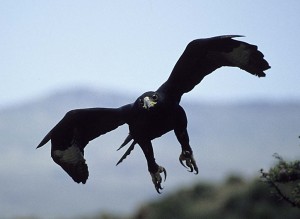
1) What is the current status of the Verreaux’s Eagle in Africa?
Favorable: on the IUCN Red List, Verreaux’s Eagle is classified as least concern. The species has a huge geographic range given as over 4 million square kilometres, encompassing much of sub-Saharan Africa and extending up the Rift Valley, just reaching the Middle East. But more important than range is the area of occupancy and density within those areas. Fortunately Verreaux’s Eagles can exist at quite high density for a large eagle species where prey populations permit (with territories as small as 10km2) and they live in mountains and in remote places so they have been less affected by human development pressures than other eagle species. Total population estimate given by Birdlife is 10k – 100k but this has not yet been based on sound measurement of their mountain habitat and there may be as many as 2000 pairs just in the Cape Province of South Africa (now known as Northern and Western Cape).
2) How has the population developed during the last decades?
It is hard to say because monitoring has only been carried out at a few localities. The Rock Hyrax prey base of Verreaux’s Eagles may be one of the most stable food supplies of any large eagle because hyrax do not fluctuate as widely in numbers as say rabbits, gamebirds or rodents. This is largely because hyrax do not create their own refuges – they use rocky crevices which are fixed over time and the stable mountainous territories of these long-lived eagles are maintained around this fixed rocky habitat. David Allan noted that Verreaux’s Eagles in the Magaliesberg breed more successfully during drought years than high rainfall years – this paradox arises from the hyrax need to move farther from their rocky shelters to find food when it gets dry and become more exposed to predation. But hyrax numbers can show a fourfold decline after extended drought. So the eagle population will have oscillated slightly over the last few decades with natural fluctuations in rainfall which in Africa are often linked to El Nino events. However some studies have detected a harmful human influence on eagle populations in high density community areas where the human population has depleted the hyrax prey base through hunting and possibly also over-grazing. Community-owned land in Transkei, Lesotho and in areas adjoining the Matobo Hills National Park in Zimbabwe are examples of this. So there is likely to have been some loss of breeding pairs over the last decades but there are still vast tracts of Africa where Verreaux’s Eagles are not heavily persecuted and are still doing very well.
3) What is known about the species in the Western Paleartic? Is it still a regular breeding species there?
The range of Verreaux’s Eagles follows the distribution of Rock Hyrax in mountainous terrain and extends across the Red Sea into southern Saudi Arabia, Yemen, Oman, Israel and Jordan. It is considered a ‘Rum speciality’ for birders visiting Jordan. But outside of Africa it is not a common species and there are only a handful of known breeding sites in the Middle East. In parts of Africa, Verreaux’s Eagle meet their ecological counterpart from the Northern hemisphere, the Golden Eagle. In Ethiopia both species nest in the Bale Mountains and maintain exclusive territories from one another. Verreaux’s Eagles extend westward as far as the Air Mountains in Western Niger but they are absent from rocky habitats with hyrax in the Sahel.
4) How does habitat destruction affect the Verreaux’s Eagles?
Fortunately it is difficult for humans to destroy mountains and rocks so the habitat for Verreaux’s Eagles and their prey is largely unchanged. I have mentioned the loss of prey populations from high density community areas and urban development may also have displaced prey populations but urban development affects only a tiny fraction of Verreaux’s Eagle range.
5) What are the main threats to the Verreaux’s Eagle in Africa?
The principal threat is the loss of prey populations through hunting by humans and displacement of hyrax from their rocky habitats. There is a long history of eagle persecution in sheep farming areas of southern Africa and at one stage the governments paid bounties for this. The levels of persecution were very high – on a par with the killing of Golden Eagles in the States and Wedge-tailed Eagles in Australia – and would have created localised population ‘sinks’. Fortunately those days are largely gone now and most farmers in southern Africa have become enlightened about the beneficial effects of having eagles on the farm. It is easy for the situation to slip and so it is important for conservation and education programmes to be ongoing. However, because they live in remote places, and because they prefer to catch live prey rather than scavenge, Verreaux’s Eagles have not suffered as badly as other large eagles through persecution and poisoning.
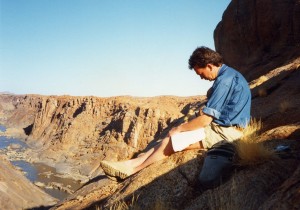
A new and worrying threat to Verreaux’s Eagles in Africa will be the provision of wind farms to provide energy. These structures, like unsafe electricity pylons before, are known causes of mortality for large raptors. It is very likely that electricity companies will want to put up wind farms in high lift areas on African mountains and ridges and these areas will converge with where Verreaux’s Eagles prefer to fly. Stringent environmental impact assessments need to be carried out to minimise this threat but it is hard to see how wind farms will not have a harmful effect on this eagle if there is an uptake in Africa along the lines seen in parts of Europe.
6) Verreaux’s Eagle are known to feed a lot on rock hyraxes? Are there places where the Verreaux’s Eagle does not depend on those mammals on feeds only on other prey like other medium sized mammals and birds?
Gustaf Rudebeck (who studied bird migration) once said to me he thought Verreaux’s Eagles were ‘more evolved’ than the similar Golden Eagle. I didn’t know what he meant initially but I have come to learn that Verreaux’s Eagles are indeed highly specialised at what they do. They are mountain specialists first and foremost and have a high aspect ratio wing design suited to slope lift. They can fly in a gale of 157kph, draw their wings in slightly and make progress into the eye of the wind, while other birds are being flung across the sky. Watching them fly with Martial Eagles was like watching jet fighters escort a bomber. But Martials and Goldens are better suited to the plains and thermal soaring. A consequence of their mountain specialisation is that Verreaux’s Eagles can and will take any small medium or large eagle prey found in this habitat. One pair I studied took over one third of Red Rock Rabbits in their diet, a lagomorph. Other pairs are known to prey heavily on Guinea fowl. I have seen them bring tortoises, monkeys and klipspringer lambs weighing approx 12kg to the nest. So Verreaux’s Eagles are effective predators of many different prey in the mountains if hyrax are not abundant.
So are they really ‘hyrax specialists’ after all? Well yes I think they are because much of their biology and behaviour is geared to hunting this one prey. For instance, although they are a bit smaller than Golden Eagles in body mass both female and male Verreaux’s Eagles have much bigger feet with a 20% wider grasp. I think this is because the average mass of Verreaux’s Eagle prey (2.6kg) is twice average prey size captured by Golden Eagles. They hunt together and maximise the element of surprise to capture these tough customers. When I studied Verreaux’s Eagles there had been a fourfold decline in the hyrax prey base due to drought and they were well protected within their rocky habitat after recent rains. Caracal Lynx appeared not able to catch any hyrax at that time but the eagles were still taking 75% of this one species in their diet. So yes I do think that Verreaux’s Eagles, although they will take other prey, can be considered highly evolved and specialised predators of rock hyrax. They are perhaps one of the most prey-specific of any avian predator.
7) How is the conservation status of hyraxes across the range of the Verreaux’s Eagle?
Hyrax numbers can show variation in numbers as I witnessed in the Karoo. This is natural and caused by rainfall patterns. They can also suffer locally from disease e.g. sarcoptic mange. But although their numbers do fluctuate somewhat they are a very successful inhabitant of all rocky habitat across Africa. Just like the eagles they find some sanctuary by living in remote mountainous places where there are usually not a lot of people. There are a couple of species of Rock Hyrax which seem to be faring well across their range. The Tree Hyrax is nocturnal and not a normal prey item for Verreaux’s Eagles but this species is more threatened by deforestation. As mentioned before there are high human population density areas e.g. Transkei, Zimbabwe and Lesotho where Rock Hyrax populations have been greatly diminished by over-exploitation.
8) What habitat do the eagles need? Can they live in habitat altered by humans?
Verreaux’s Eagles need mountains where there is a sufficient food supply. Unlike more heavily persecuted species such as Martial Eagles, Verreaux’s Eagles can become extraordinarily confiding to people. Valerie Gargett, who did the monumental study of this species in the Matobo Hills, habituated one female eagle to the degree that she could place her hand underneath this incubating female, take out her eggs for measurement and then replace them. Other eagles can lose their inhibition through exposure to regular visits to nests and these birds will swoop within metres of anyone visiting the nest, treating people just as they do other nest predators e.g. baboons. I once watched a female incubating while National Park staff were loading heavy rocks onto a lorry making an awful din just 20m below the nest – the chicks hatched. There are some amazing situations in South Africa where Verreaux’s Eagles are nesting successfully within the precincts of big cities. Anyone visiting Johannesburg should make a trip to Roodepoort Botanical Gardens to see them. So yes they can survive even where there is major urban development as long as they can find the food that they need within a radius of say 10km or so.
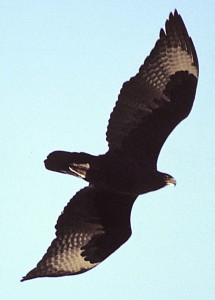
9) How large are the typical home ranges of an established pair?
The furthest I saw my eagles travel from the nest to find food was 7km but they probably can move much further than this under some circumstances. The observed home ranges of Verreaux’s Eagles in my study varied from 10km2 to 50km2 but there was 5-10% overlap in these ranges and sometimes they wandered out great distances over the plains. The average defended area of suitable habitat or territory size was 24km2. A very high density exists in the Matobo Hills in Zimbabwe where Val Gargett estimated average territory size to be 11km2 in the park and 35km2 outside. I mapped the rocky habitats in three eagle territories and found that each defended approx 52km of linear rock outcrop even though the areas of the territories varied considerably. In other mountain ranges in Africa where rock crevices and Rock Hyrax are more dispersed, Verreaux’s Eagles have larger territories, of 35km2 (Magaliesberg) – 65km2 (Drakensberg, Cape, Kenya)
10) How large should an area be to sustain a healthy population of Verreaux’s Eagles?
It depends on the density of rock crevices and Rock Hyrax and how many breeding pairs comprise a ‘healthy’ population. One thousand square kilometres of good rocky habitat should support 40 pairs of eagles which is a useful population. But you would need ten times this area in a region where rock outcrops are more dispersed to support a population which might be argued to be genetically viable on its own (min. 500 individuals or 175 pairs). These are large areas and there are insufficient protected areas even at the lower end of this scale for the total protection of the species. Fortunately Verreaux’s Eagles fare very well on farmland outside protected areas. Mountains sometimes form irregular and disconnected networks of rocky habitat so a sound conservation strategy for Verreaux’s Eagle should take account of isolated populations and the movement areas between these.
11) What is known about the dispersal and movement of juvenile and immature birds?
One very good movement corridor Verreaux’s Eagles is the African continental escarpment which surrounds the Afro-montane belt and does help provide a continuum of habitat for the species. There is always some movement of air around this major topographical feature which provides lift and helps the birds cover great distances in short periods of time. There is a constant movement of non-breeding birds around this escarpment but they have to run the gauntlet of the territorial birds and are harassed and harried along their way. Young eagles leave their natal territories about four months after fledging and are not welcomed back by the adult birds after that time. I once observed a gang of five juvenile eagles moving as a group, perhaps deriving some safety in numbers. Verreaux’s Eagles exhibit various levels of intensity of territorial behaviour. A captive bird that I hand-raised and kept at liberty in the Karoo National Park was tolerated at the edges of three territorial pairs for two years but when she moulted into adult black plumage the attacks by the wild birds became much more serious and I had to relocate her. It is likely that dispersing birds can cover hundreds of kilometres in days or weeks and the quick return of translocated eagles confirms this. But the few recoveries from an extensive ringing programme in the Matobo Hills were mostly from within tens of kilometres of natal areas, occasionally hundreds of kilometres. Because most territories are likely to be stable and occupied by these long-lived birds, it must be very hard for young eagles and non-breeders to find their way in the world. It is likely that they face a very high mortality rate. However there are large extents of rocky habitat within Africa which are home to hyrax but do not afford nesting cliffs for the eagles. These ‘marginal’ areas must be very useful for the survival of the floating population.
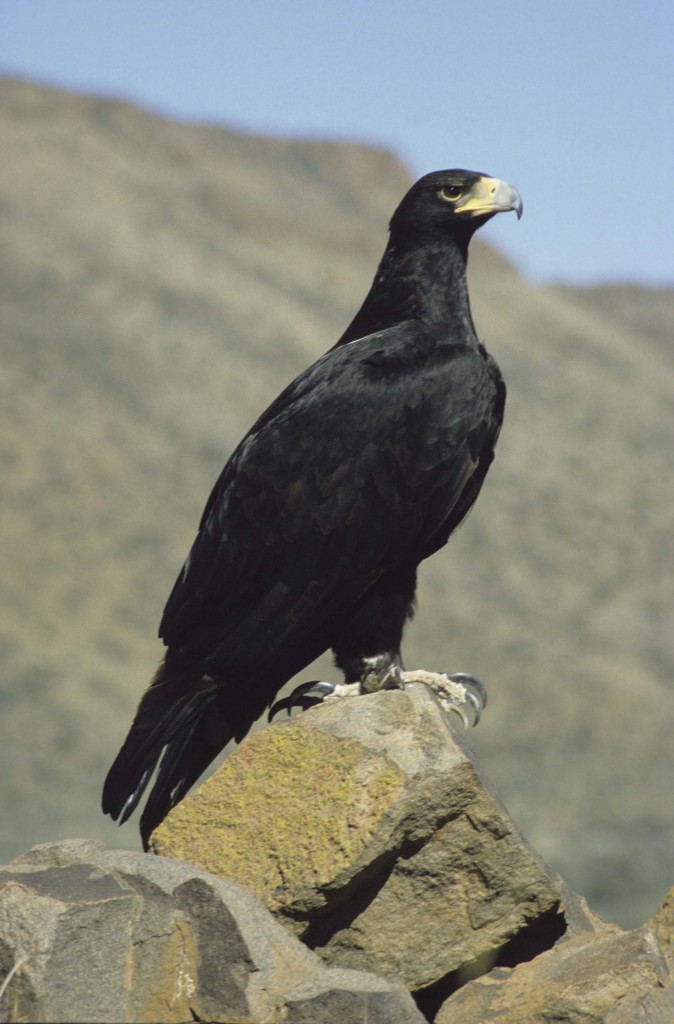
12) Is the second born chick always killed or are there any known cases where two young fledged?
The Verreaux’s Eagles is one of a few raptor species that shows ‘obligate siblicide’ where, if two chicks hatch, the younger of the two almost always succumbs to starvation and bullying by the elder chick. Verreaux’s Eagles often lay two eggs and this offers them an insurance in case the first egg fails to hatch (a 21% likelihood in my study). I follow Rob Simmons’ argument that the adaptive significance of this strange biological phenomenon is that the young of these species need to be raised to become as strong as possible (offspring quality rather than quantity). I think this is especially important for Verreaux’s Eagles because I believe breeding opportunities for maturing eagles come about less often than in most other eagle populations on account of the stable prey base. The prey base of Golden Eagles for instance often shows a 30 fold variation in numbers compared to a 4 fold variation in hyrax and Golden Eagles can raise up to three young to take advantage of opportunities that arise in their world. On extremely rare occasions Verreaux’s Eagles have been recorded to raise two young from a single nesting attempt. I have heard of at least three such events from South Africa. In some of these instances, the chicks may have been sufficiently separated (on different parts of the nest or ledges) during the crucial stage when siblicide normally takes place.
13) What gaps in our knowledge of this large eagle do still exists?
We need more knowledge on the life histories of Verreaux’s Eagles: more detail on how and where the juveniles disperse (possibly by satellite tracking); and more information on the longevity and lifetime reproductive success of known individuals (through marking).
My own interest was in studying the effects of predation by Verreaux’s Eagles – harmful effects by predation on sheep (which does happen occasionally) and beneficial effects by predation on hyrax and reducing the impact of hyrax on grazing resources. I was able to carry out a comprehensive study of the predation rate by these eagles and conclude that the benefits of having eagles on the farm outweighed the costs by 150 times. But I did not get the opportunity to look at some of the ultimate causes of lambs or hyrax falling prey to the eagles. In determining the impact of a predator on its prey it is important to know whether the prey were ill or perhaps already dying when they were captured by the eagles. In these cases the predation is known as compensatory mortality and it does not have so much impact on a prey population as the removal of healthy individuals. The age structure of the hyrax captured by the eagles suggests that a lot of these are healthy individuals which might otherwise contribute to their populations but it would be great if someone could do a study on the bone marrow fat content of different prey remains from Verreaux’s Eagles’ nests (or any eagle for that matter) to try to throw more light on the condition of the prey when captured. It is especially important in the case of livestock predation and understanding the economic impact of these predators. An extensive field study including autopsies of lambs delivered to eagle nests or found dead in lambing paddocks would be very valuable work. We also need to know more about deterrents such as taste aversion which can be used by livestock managers to minimise any losses to eagles.
14) Where should research focus during the next years?
The most important work will be to monitor Verreaux’s Eagles in as many different regions of Africa as possible especially in locations where we suspect hyrax populations may be heavily hunted by people and especially in places where wind farms are constructed or likely to be proposed. Any research which demonstrates how wind farms could be deployed without putting Verreaux’s Eagles at risk would be possibly the most valuable of all. This research might look very closely at where these eagles prefer to fly topographically. The testing of possible deterrents to flying eagles which might keep them away from wind turbines would be very worthwhile and could benefit other large raptors. If some of the population monitoring work can include the marking of individual birds it will help provide useful information on life history and population turn-over. After that, extensive field necropsy work of lamb mortality will likely strengthen the case for conserving this eagle and may provide management indicators. It would be of great interest to study Verreaux’s Eagles and Golden Eagles where they occur side by side in Ethiopia and learn more from the differences or similarities of these two close species.
15) What can and must be done to secure the survival of the Verreaux’s Eagle?
The incorporation of arguments explaining why we need to conserve these large eagles into school curricula, possibly agricultural college curricula and into ongoing conservation efforts in all parts of Africa needs to be ongoing. Even where we worked so hard with farmers in the Beaufort West area and achieved so much, eagle killings were reported after the local programme ceased. So I don’t think we can ever rest on our laurels and think ‘job done’, we need to keep on and on motivating for the conservation of these birds. The education programmes are going to be most important in areas where human communities can damage the environment for eagles. But we cannot ask people to starve so that eagles survive. Local communities need to be assisted to sustainably manage their local resources and they also need to benefit from the protection of wildlife. The provision of food from culling programmes in Pilanesburg National Park to local communities is an excellent example of how this can be achieved in practice. We need to make a fuss about these magnificent eagles, show them to the public and generate tourism around them. Stringent environmental impact assessments and campaigning will be necessary to ensure that wind farms do not replace the beautiful sight of a Verreaux’s Eagle flying over an African mountain.
16) You did the sketches in wonderful book “The Black Eagle (Verreaux’s Eagle) – a Study” by Valerie Gargett. The book is considered to be one of the best monographs on any raptor ever written. Could you tell us a bit about the book for those who don’t know it? Is the study of the eagle population mentioned in the book continued today and what is known about the conservation status of the eagles in the Matobo Hills?
Valerie Gargett passed away recently but she has left an amazing legacy of knowledge and concern for Verreaux’s Eagles. I was very lucky to have known this charming lady and worked with her to illustrate her story. She was so overjoyed with some of the images that I and Graeme Arnot (who did the paintings for the book) produced that it made work on the project a great pleasure. She, together with her husband Eric, and an army of volunteers created what has become the largest scale and longest duration study of a large eagle species anywhere in the world. It began in the Matobo Hills of Zimbabwe nearly 50 years ago with observations on 11 pairs in the park, and it grew to follow the fortunes of 60+ pairs inside and outside the park. It is testament to the drive of Val Gargett, George Banfield and now members of the Matebeleland Branch of Birdlife Zimbabwe that this vital project has continued even through the troubled times that this country has experienced. Peter Mundy from Bulawayo informs me that in 2009 the teams reported 19 youngsters from 39 pairs monitored which is just under 50% success rate and not abnormal.
The book documents the first two intense decades of this amazing study. The book is set in the Matobo Hills, a paradise for wildlife and particularly birds of prey. In amongst the fantastic granite boulders and domes an ecological community thrives in which hyrax and their predators play a dominant role. The other predators include leopard, Black Mambas, Crowned Eagles, African Hawk Eagles and there is a chapter in the book about this whole community. Val’s team had many adventures while recording the nesting biology of the Verreaux’s Eagles. These adventures are told but the book is fundamentally an in depth account of every aspect of the eagle’s natural history with emphasis on the nesting biology. Val recounts anecdotes and amazing observations on the relationships that forge between the eagles and also between the eagles and their observers. She won the confidence of the wild eagles and her ardent enthusiasm for these birds provided the drive and foundation for a loyal and dedicated team of eagle followers.
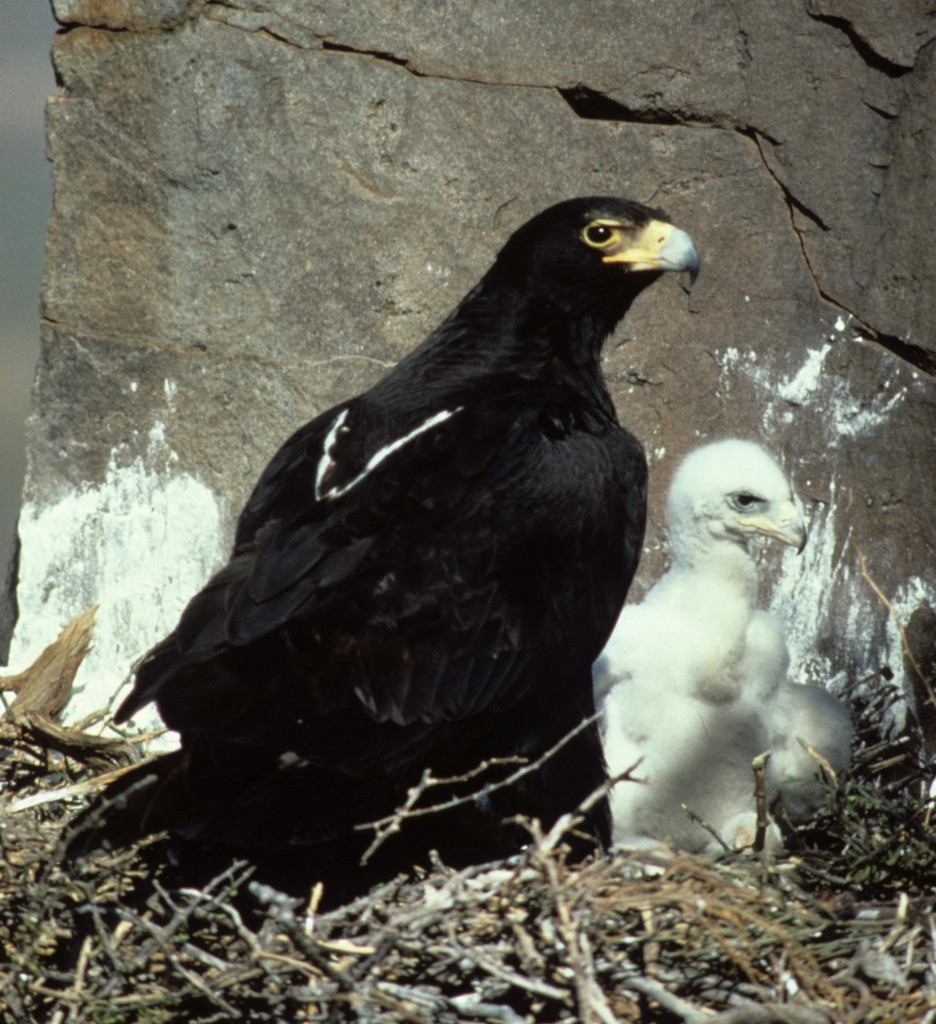
17) Are there any conservation projects for the species done at the moment?
There are two large monitoring projects for Verreaux’s Eagles running at the moment: one in the Matobo Hills (39 pairs) and a second in various mountain ranges of the Cape, South Africa (35 pairs). The latter has been initiated and organised by another dynamic eagle devotee, Lucia Rodrigues from the South West Cape Raptor Group (affiliated to the Bird of Prey Working Group at EWT Johannesburg). Last year Lucia saw 17 out of 31 pairs followed through successfully raise chicks. These monitoring programmes are vital and Lucia is comparing breeding success at various sites so that she can pick up any early signs of problems with the populations. This is going to become especially important in areas where the human population is increasing fast and in areas where wind farms are proposed. Lucia has also tagged 14 juveniles (patagial) to follow their fortunes. One bird dispersed 90km by its second year. There are various other ad hoc projects to assist Verreaux’s Eagles in South Africa including a proposal to fit a satellite transmitter to fledglings at the Johannesburg Botanical Gardens site, and there has been successful provision of an artifical nesting platform in Klipriviersberg
18) How do you see the future of the Verreaux’s Eagle?
The human population of the southern African development community (South Africa up to Tanzania and the DRC) stands at 300 million today and is expected to double over the next 25-30 years. The expected land use change that will accompany this growth is the biggest threat to wildlife in the region. Undoubtedly Verreaux’s Eagles will be affected negatively by human population pressure, notably depletion of hyrax populations and also by the development of wind farms on African mountains. But if we can monitor these risks in different parts of Africa I believe there is enough support for conserving these magnificent birds, especially in the more developed regions, and that we will be able to mitigate many of the harmful effects. The biggest advantage Verreaux’s Eagles hold over other large raptors at risk is that they inhabit remote mountainous terrain which is difficult for people to get to, and thankfully there are still a lot of wild mountainous places in Africa that should preserve a substantial population of this species into the future. So I see their future as relatively safe but we should never be complacent about the status of any large eagle in today’s world, and the future security of this species is dependent upon the continued dedication of key people who are able to keep an eye on things and mobilise public concern as problems arise.
19) What was your most amazing experience with the Verreaux’s Eagle?
There were so many it is hard to choose from but it was witnessing the capture of first prey by the baby Verreaux’s Eagle that I had hand-raised. Finding the way to independence for this bird in the wild was perhaps the biggest challenge I have faced while working with any wildlife. Samburu, as she was known, had spent two years at liberty since fledging and we had encountered many problems along the way not least the fact that if I dropped her weight to encourage her to hunt she would swoop on visiting tourists and dignitaries even the Chairman of South Africa National Parks (not hurting them but terrifying them)! I had taken steps to avoid the imprinting process but clearly Samburu had few inhibitions with people. Although she had learned to fly superbly in the updrafts over the small koppie where she lived, I don’t think she had ever killed for herself and was still very reliant on me to provide food. Anyway, we were filming her for a Natural World episode one day and she followed me and the film crew to the long rocky outcrop that ran horizontally along the lower slopes where I spent time with her each day. I went on ahead and unexpectedly flushed a Red Rock Rabbit from the vegetation above the ridge. Samburu was out from the ridge behind me at about 50m altitude. I called out and just as I turned to see if she had actually spotted the rabbit I saw her fold her wings into a big heart shaped black silhouette and begin a steep dive below the outcrop. It was as if all the evolution and experience of being a Verreaux’s Eagle suddenly kicked in. Samburu had seen the rabbit very clearly and had a plan. Other biologists dismiss this notion as anthropomorphic, but Samburu had very clearly plotted the course that this rabbit was taking and deliberately plunged out of view of her intended prey as I had seen the wild eagles do. She must have been unsighted from her intended prey as she covered the last 60m or so at great speed. As I watched the rabbit career towards this long line of rocks I became slightly incredulous about the ambition of the invisible eagle. But Samburu swung up under the outcrop and she snatched the rabbit head-on just as it raced over the top of the rock: at exactly the right moment, in exactly the right place. To witness that level of skill and power so close by, and for it to be this young eagle that I had worked so hard with to win her independence was for me, my most amazing Verreaux’s Eagle moment.

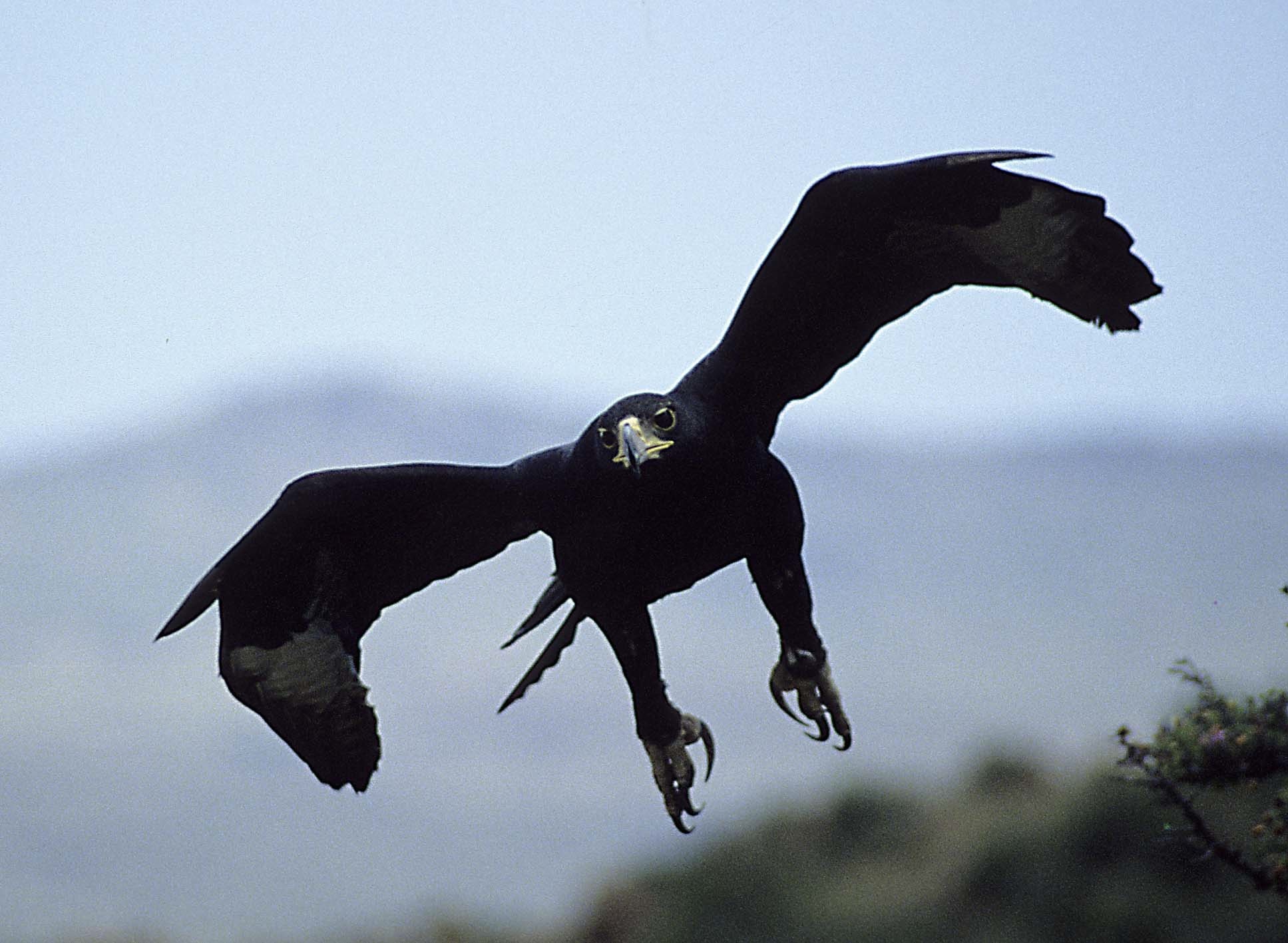


Super interview!
Keep them coming.
Keith
This is a great nterview with some good info on what is my opinion one of the most beautiful of the eagles.
Fantastic interview!
Great stuff – thanx
Great interview! Please, post more like that!
Thanks for the great comments. I am very happy that you like the interviews. Rob shared a lot of knowledge about those amazing eagles.
More will follow. Stay tuned!
Markus
An excellent summary Rob. You’re a great ambassador for raptor researchers and the final paragraph of your summary is compelling reading.
Good work mate!
Excellent Rob, thanks for sharing your knowledge with us!
Brilliant work…………a great inspiration,
Research and the art is how I pass on information to the public who would probably not sit down and read a thesis work!!
cheers
Interesting interview! Loved samburu’s story… Met two of your friends from Cardiff at a party in France a week ago!
A great read!!
Always prepared to learn more from V eagle experts so keep us posted PLEASE !!
An excellent summary Rob. You’re a great ambassador for raptor researchers and the final paragraph of your summary is compelling reading. Good work mate!
lovely stuff; thanks for sharing. would like to know more about black eagles in cape town – any suggestions?
thank you
Always interested to learn more and Rob you have shared so much. Over the last 4 years I have had the privilege to observe a breading pair on my doorstep so to speak and they have successfully raised 3 chicks. A lot of the characteristics you discribe I have seen in these birds which now makes sense.
Rob a fitting acknowledgement to Lucia Rodrigues – the tireless work she does is invaluable.
Great and insightful interview. I have flown captive bred Verreaux Eagles since 1996, and now also have a pair in an aviary from which I hope to learn the requirements for captive breeding. One day (having just read Val’s book) I vowed I’d travel to see them in the wild, and this interview spurs me further toward seeing and studying them in their environment.
Thank You
Nice to read and hear that you are still at it. So many challenges in Botswana conservation for big raps. Make contact if you like.